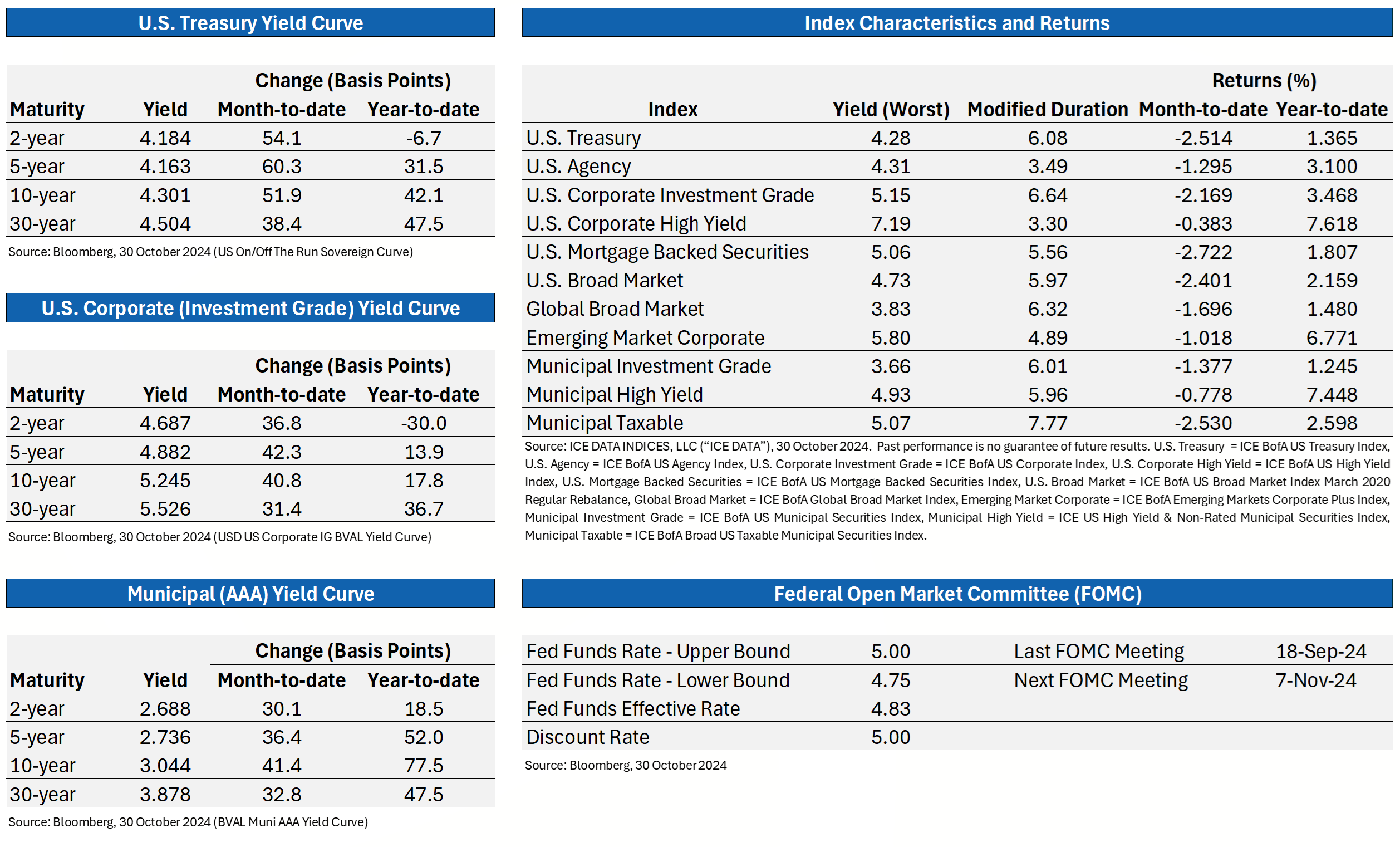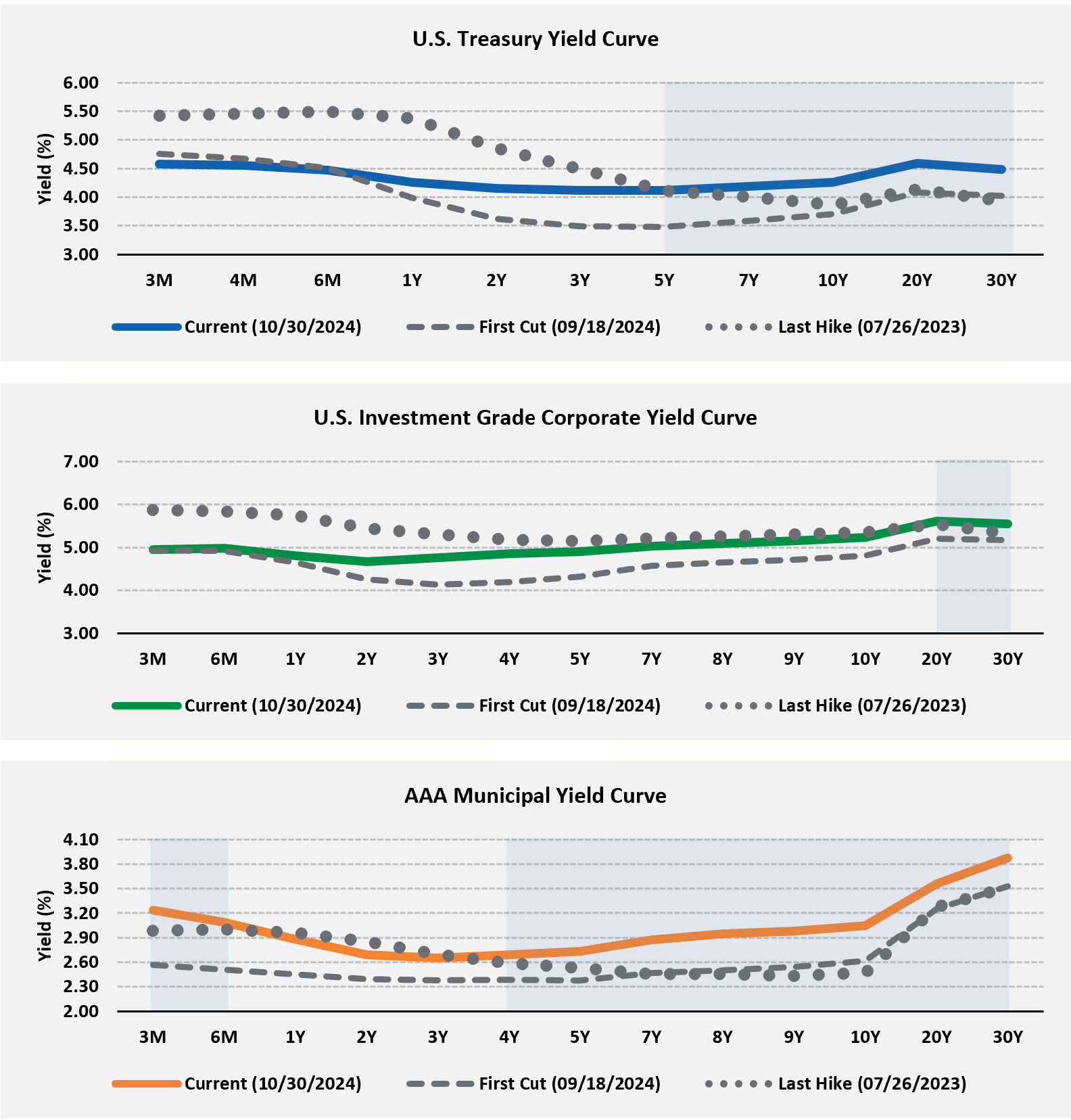Download the 11.1.24 Dynamic Bond Market Update for advisors’ use with clients
By Bill Smith, Fixed Income Trader and Portfolio Manager
It has been six weeks since the Federal Reserve (Fed) commenced its easing campaign with a 50-basis point (bps) “jumbo” cut to interest rates. Next week, an additional 25 bps cut is widely anticipated at the November 6-7 Federal Open Market Committee meeting. While shorter bonds have largely performed as expected in this environment, longer maturities across major fixed income indices have seen yields spike higher. Nowhere is this more apparent than the U.S. Treasury market, where yields from two to thirty years have risen over 50 bps ± since September 18. The largest driver of this move appears to be the strength of the U.S. economy, which many believe will result in a more measured approach to policy easing than initially anticipated. Today’s third-quarter GDP print at 2.80% should reinforce this narrative, as growth in 2024 appears on target to exceed the Fed’s 2% projection. Bloomberg’s interest rate probability model now calls for approximately 125 bps in total cuts by the end of 2025, roughly 75 bps lower than estimates from early October. This recalibration has led to negative performance across most fixed income indices this month, with U.S. mortgage-backed securities, Treasuries, and taxable municipal bonds seeing the largest underperformance. The charts below summarize the yield change and performance of select fixed income tenors and indices as of October 30.
Past performance is no guarantee of future results.
Higher Yields After a Rate Cut?
While current fixed income market volatility may seem surprising, our research indicates that negative performance after a first cut isn’t unusual over shorter time horizons. Looking at the beginning of the previous ten easing cycles since 1989, the six-week performance of the U.S. Bloomberg Aggregate Bond index was negative 40% of the time (4/10). Broadening the scope to include all fifty-seven rate cuts since June 1989, six-week performance was negative nearly a third of the time (18/57). While we are still in the early innings of this easing cycle, lower prices and higher yields seem reasonable given the uncertainty surrounding the future path of interest rates.
Yield Opportunities Abound
The recent pullback in prices across the fixed income markets should provide income-oriented investors additional opportunities to add yield to their portfolios. For example, the U.S. Bloomberg Aggregate Bond index currently yields about 4.70%, nearly 60 bps above the year-to-date lows set in September and over 180 bps more than its ten-year average of 2.87%. The charts below compare the current yield curves (10/30/24) of U.S. Treasury, U.S. investment grade corporate, and AAA municipal bonds to 1. The yields available after the first rate cut of this cycle (09/18/2024) and 2. The last rate hike of the previous tightening cycle (07/26/2023).
Source: Bloomberg. Past performance is no guarantee of future results.
As shown, longer maturities broadly yield more today than after the last rate cut in September. Even more interesting, the data reflects we are getting higher yields than when the Fed was hiking rates, as shaded in blue. Rather than retreat from duration, now may be a good time to explore maturities farther out on the curve, especially for investors looking to lock in yields for the long term.
A prudent approach to fixed income investing calls for diversification across both credit and duration exposure. As always, Dynamic recommends staying balanced, diversified and invested. Despite short-term market pullbacks, it’s more important than ever to focus on the long-term, improving the chances for investors to reach their goals.
Should you need help navigating fixed income for your clients, please contact Dynamic’s Investment Management team at (877) 257-3840, ext. 4 or investmentmanagement@dynamicadvisorsolutions.com.
Bill Smith serves as president, Portfolio Management & Trading, of Harmont Fixed Income in Phoenix
Disclosures
This commentary is provided for informational and educational purposes only. The information, analysis and opinions expressed herein reflect our judgment and opinions as of the date of writing and are subject to change at any time without notice. This is not intended to be used as a general guide to investing, or as a source of any specific recommendation, and it makes no implied or expressed recommendations concerning the manner in which clients’ accounts should or would be handled, as appropriate strategies depend on the client’s specific objectives.
This commentary is not intended to constitute legal, tax, securities or investment advice or a recommended course of action in any given situation. Investors should not assume that investments in any security, asset class, sector, market, or strategy discussed herein will be profitable and no representations are made that clients will be able to achieve a certain level of performance, or avoid loss.
All investments carry a certain risk and there is no assurance that an investment will provide positive performance over any period of time. Information obtained from third party resources are believed to be reliable but not guaranteed as to its accuracy or reliability. These materials do not purport to contain all the relevant information that investors may wish to consider in making investment decisions and is not intended to be a substitute for exercising independent judgment. Any statements regarding future events constitute only subjective views or beliefs, are not guarantees or projections of performance, should not be relied on, are subject to change due to a variety of factors, including fluctuating market conditions, and involve inherent risks and uncertainties, both general and specific, many of which cannot be predicted or quantified and are beyond our control. Future results could differ materially and no assurance is given that these statements or assumptions are now or will prove to be accurate or complete in any way.
Past performance is not a guarantee or a reliable indicator of future results. Investing in the markets is subject to certain risks including market, interest rate, issuer, credit and inflation risk; investments may be worth more or less than the original cost when redeemed.
Investment advisory services are offered through Dynamic Advisor Solutions, LLC, dba Dynamic Wealth Advisors, an SEC registered investment advisor.
Photo: Adobe Stock


